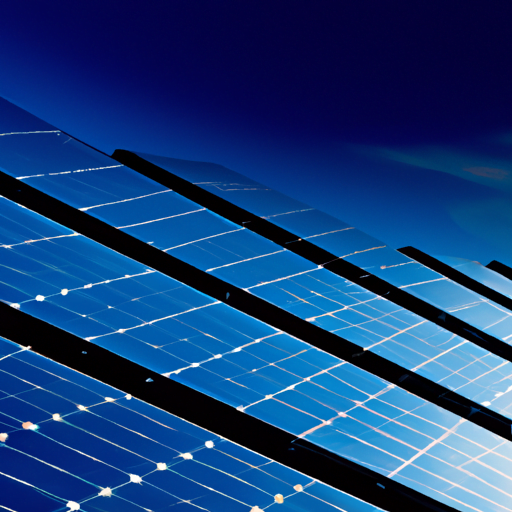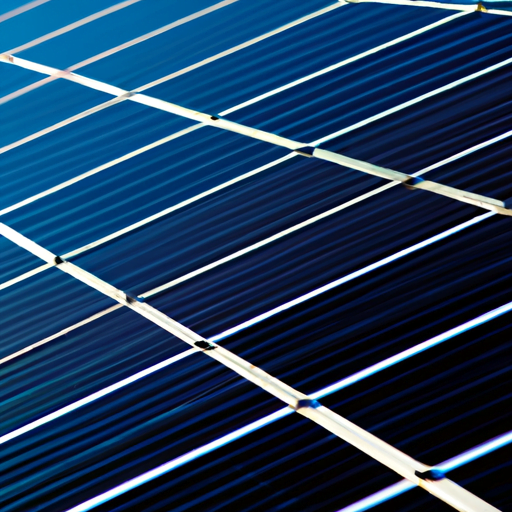So, you’re wondering if solar panels work on moonlight? It’s an interesting question, especially if you’re living off the grid and relying on renewable energy sources. We all know that the sun is the primary source of energy for solar panels, but what about that gentle glow of the moon? Can it actually power your home? Well, the answer might surprise you.
While moonlight is much dimmer than sunlight, it still contains a small amount of solar energy. The moon reflects sunlight, so technically, solar panels can generate a small amount of electricity from moonlight. However, the efficiency is significantly lower compared to direct sunlight. The energy produced by moonlight is usually not sufficient to power a home, especially if you have a high energy demand.
So, the short answer is yes, solar panels do work on moonlight, but it’s not really practical for powering your entire home. In fact, you would need a really large number of solar panels to generate a significant amount of electricity from moonlight alone. Instead, solar panels are designed to capture and convert the stronger sunlight energy, which provides a much more efficient and reliable source of power.
If you’re interested in learning more about the effectiveness of solar panels under moonlight, keep reading our article. We’ll delve into the science behind it, explore some of the challenges, and discuss alternative energy storage solutions that could help you maximize the use of solar panels even during those moonlit nights.

Understanding Solar Panels
Solar panels are devices that convert sunlight into electricity. The process involves the use of photovoltaic cells, which are capable of converting solar energy into electrical energy through the photovoltaic effect. This phenomenon occurs when sunlight hits the surface of the solar panel, causing the electrons in the photovoltaic cells to be excited, thus generating an electric current.
Solar panels offer numerous benefits, making them an increasingly popular choice for both residential and commercial properties. These benefits include reducing electricity bills, decreasing reliance on fossil fuels, and contributing to a cleaner and more sustainable environment. Additionally, solar panels require minimal maintenance and have a long lifespan, making them a cost-effective investment in the long run.
Exploring the Effectiveness under Moonlight
Can solar panels generate electricity under moonlight?
Solar panels are designed to harness the energy from sunlight, but can they also generate electricity under moonlight? The answer is not as straightforward as one might think. While the moon does reflect sunlight, it only reflects a fraction of the sun’s rays, resulting in significantly less energy available for solar panels to convert into electricity.
Factors affecting solar panel effectiveness under moonlight
Several factors influence the effectiveness of solar panels under moonlight. One crucial factor is the phase of the moon. During a full moon, when the moon is directly opposite the sun, more sunlight is reflected, leading to a potential increase in energy production. In contrast, during a new moon, the moon is between the sun and the earth, resulting in minimal reflected sunlight and lower energy output.
Another important factor is the angle of the solar panels. Solar panels are usually angled to maximize their exposure to the sun. However, this optimal angle may not be ideal for capturing moonlight. Adjusting the angle of the solar panels can help optimize their effectiveness under moonlight conditions.
Comparing solar panel efficiency under moonlight and sunlight
While solar panels can generate some electricity under moonlight, their efficiency is significantly lower compared to direct sunlight. This is due to the lower intensity and indirect nature of moonlight. Solar panels typically rely on the high intensity and direct angles of sunlight to generate significant amounts of electricity. Therefore, it is important to understand that their effectiveness under moonlight is limited.
Scientific Analysis
Research studies on solar panel performance under moonlight
In recent years, there have been several research studies conducted to evaluate the performance of solar panels under moonlight. These studies aim to determine the feasibility of using solar panels to generate electricity during nighttime hours or in low-light conditions.
One study conducted by researchers at the University of California, Davis, investigated the electrical output of solar panels under different phases of the moon. The results revealed that solar panels could generate a small amount of electricity under moonlight, but the energy produced was significantly lower compared to sunlight.
Understanding the impact of different wavelengths on solar panel effectiveness
Another aspect that researchers have explored is the impact of different wavelengths of light on solar panel effectiveness. Moonlight consists of a different spectrum of light compared to sunlight, with a higher proportion of blue and green wavelengths. These studies suggest that solar panels may be more efficient at converting certain wavelengths of light into electricity, potentially improving their performance under moonlight.
However, it is important to note that these findings are still in the early stages of research, and further studies are required to fully understand and optimize solar panel performance under moonlight.

Optimizing Solar Panel Performance
Innovations to enhance solar panel efficiency under moonlight
In order to optimize solar panel performance under moonlight, researchers and industry experts have been considering various innovations. One potential solution is the development of solar panels specifically designed to capture and utilize the unique wavelengths of light found in moonlight. These panels would be optimized for low-light conditions, maximizing energy conversion and output.
Another approach involves further advancements in solar cell materials and designs. By improving the efficiency of solar cells, more energy can be captured even under low-light conditions, including moonlight. Researchers are exploring new materials and structures that can enhance the performance of solar panels, making them more effective in converting light into electricity.
Technological advancements in solar panel design for low-light conditions
With the increasing demand for solar panels in various environments, technological advancements have been made to improve their performance under low-light conditions. One such advancement is the integration of tracking systems. These systems allow solar panels to move throughout the day, tracking the movement of the sun or moon and optimizing their exposure to light. By constantly adjusting their position, solar panels can maximize their energy output, even under moonlight.
Another technological advancement is the use of bifacial solar panels. Unlike traditional solar panels that only capture sunlight from one side, bifacial panels have solar cells on both the front and back surfaces. This design allows the panels to capture light from both the sun and the reflected light from the ground, potentially increasing their effectiveness under moonlight.
Solar Panel Installation Tips
Choosing the right solar panels for low-light environments
When considering the installation of solar panels in low-light environments, it is important to choose panels that are specifically designed for such conditions. Certain manufacturers offer solar panels with enhanced low-light performance, which can be beneficial in maximizing energy production under moonlight. Researching and selecting panels with the appropriate specifications is crucial for optimal performance.
Installation considerations for optimal performance under moonlight
To ensure optimal performance of solar panels under moonlight, proper installation is key. Installing the panels at the correct angle is crucial for capturing the available moonlight. Additionally, minimizing shading from nearby structures or trees is essential to maximize the amount of light reaching the solar panels. Regular maintenance, including cleaning the panels to remove dust and debris, can also improve performance.
Cost-effectiveness of Moonlight Solar Panels
Comparative analysis of the cost-efficiency of moonlight solar panels
When evaluating the cost-effectiveness of solar panels, it is essential to consider both the initial investment and long-term savings. While moonlight solar panels may have a lower energy output compared to those optimized for sunlight, they can still contribute to significant savings over time, especially in low-light environments. The reduced energy generation may be compensated by lower energy consumption and associated savings.
Long-term savings and return on investment
Investing in solar panels, whether optimized for sunlight or moonlight, offers long-term savings and a favorable return on investment. By decreasing reliance on traditional energy sources, solar panels can significantly reduce electricity expenses. Additionally, with proper maintenance and longevity, solar panels can operate effectively for decades, ensuring continuous savings and a positive return on investment.
Practical Applications
Utilizing solar panels for off-grid living scenarios
Solar panels have become indispensable for off-grid living scenarios. Whether in remote cabins or recreational vehicles, solar panels provide a reliable and sustainable source of electricity, even under moonlight conditions. Off-grid living allows individuals to have greater independence from the grid and enjoy the benefits of renewable energy.
Industrial and commercial applications of moonlight solar panels
The applications of moonlight solar panels are not limited to residential settings. Industries and commercial establishments can also benefit from harnessing moonlight as an alternative energy source. Areas with limited access to sunlight, such as underground facilities or buildings surrounded by tall structures, can still generate some electricity through moonlight solar panels, reducing their dependence on external power sources.
Environmental Impact
Reducing carbon footprint with moonlight solar panels
Solar panels, whether operating under sunlight or moonlight, contribute to reducing carbon emissions and minimizing the environmental impact of energy production. By utilizing renewable energy sources, like solar power, individuals and businesses can significantly reduce their carbon footprint, helping combat climate change and create a more sustainable future.
Renewable energy solutions for a sustainable future
Exploring the effectiveness of solar panels under moonlight is just one step towards achieving a sustainable future. It highlights the importance of diversifying renewable energy sources and optimizing their utilization in different environmental conditions. Combined with other clean energy solutions, solar panels play a vital role in transitioning towards a more sustainable and environmentally friendly energy system.
Challenges and Limitations
Addressing challenges in harnessing moonlight energy
While solar panels show promise in generating electricity under moonlight, several challenges exist that need to be addressed. The limited energy output and variability due to different moon phases and angles of reflection present significant obstacles to utilizing moonlight energy efficiently. Ongoing research and development efforts aim to overcome these challenges and improve solar panel performance under moonlight conditions.
Limitations of solar panels in low-light conditions
Solar panels are designed to operate optimally under direct sunlight. As such, their performance is inherently limited in low-light conditions, including moonlight. The lower intensity and indirect nature of moonlight result in lower energy conversion rates. While advancements are being made to enhance solar panel efficiency under these conditions, it is important to recognize their limitations and consider alternative energy sources where solar panels may not be the most effective solution.
Conclusion
In conclusion, solar panels can generate a certain amount of electricity under moonlight, albeit with reduced efficiency compared to direct sunlight. The effectiveness of solar panels under moonlight is influenced by various factors, including moon phase, angle of reflection, and solar panel design. Innovations and advancements in solar panel technology aim to enhance their performance under low-light conditions. By considering the specific requirements and optimizing the installation of solar panels, individuals and businesses can reap the benefits of moonlight solar panels. From cost savings to reducing carbon emissions and improving sustainability, the exploration of solar panel effectiveness under moonlight paves the way for a brighter future powered by renewable energy.




